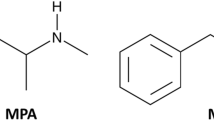Abstract
The effects of mescaline hydrochloride (4.95–79.2 mg/kg i.p.) and its non-hallucinogenic analogue 3,4-dimethoxyphenylethylamine hydrochloride (DMPEA) (12.5–100 mg/kg i.p.) on shock avoidance in a shuttlebox were studied in male Long-Evans rats trained to high (above 88%, good performers) or low (below 6%, poor performers) stable base-line avoidance rates. In good performers, mescaline and DMPEA caused a dose-dependent decrease in avoidance rate (ED 50's 44.6 and 39.2 mg/kg, respectively) without affecting presession (5-min adaptation peroid) or intertrial shuttlebox crossings. In poor performers, mescaline caused a dose-dependent increase in avoidance rate (ED 50=24.8 mg/kg) and intertrial crossings, without affecting presession crossings. The results suggest that mescaline, but not DMPEA, has dual facilitative and disruptive effects on avoidance behavior at similar dose ranges. The facilitative, but not the disruptive, effect may be related to changes in motor activity.
Similar content being viewed by others
References
Appel, J. B.: Effects of LSD on time-based schedules of reinforcement. Psychopharmacologia (Berl.) 21, 177–186 (1971)
Bailey, P. T., Pradhan, S. N.: Effects of Δ9-tetrahydrocannibanol and mescaline on self-stimulation. Neuropharmacology 11, 831–838 (1972)
Banerjee, U.: Acquisition of conditioned avoidance response in rats under the influence of addicting drugs. Psychopharmacologia (Berl.) 22, 133–143 (1971)
Bignami, G., Robustelli, F., Janku, I., Bovet, D.: Action de l'amphetamine et de quelques agents psychotropes sur l'acquisition d'un conditionnement de fuite et d'évitement chez des rats sélectionnés en fonction du niveau particulièrement bas de leurs performances. C. R. Acad. Sci. (Paris) 260, 4273–4278 (1965)
Bridger, W. H., Mandel, I. J.: The effects of dimethoxyphenylethylamine and mescaline on classical conditioning in rats as measured by the potentiated startle response. Life Sci. 6, 775–781 (1967)
Bridger, W. H., Mandel, I. J.: Excitatory and inhibitory effects of mescaline on shuttle avoidance in the rat. Biol. Psychiat. 3, 379–385 (1971)
Bridger, W. H., Mandel, I. J., Stoff, D. M.: Mescaline: No tolerance to excitatory effects. Biol. Psychiat. 7, 129–138 (1973)
Brown, M. L., Lang, W. J., Gershon, S.: Pharmocological and behavioral effects of 3,4-dimethoxyphenylethylamine in conscious and anesthetized animals. Arch. int. Pharmacodyn. 158, 439–452 (1965)
Brown, W. T., McGeer, P. L., Moser, I.: Lack of psychotomimetic effect of para-methoxyphenylethylamine and 3,4-dimethoxyphenylethylamine in man. Canad. Psychiat. Ass. J. 13, 91–92 (1968)
Bueno, O. F. A., Masur, J., Breda, J. B., Carlini, E. A.: Effects of homoveratrylamine on the operant behavior of rats: Potentiation by phenelzine. Acta physiol. lat.-amer. 19, 181–187 (1969)
Charalampous, K. D.: Comparison of metabolism of mescaline and 3,4-dimethoxyphenylethylamine in human. Behav. Neuropsychiat. 2, 19, 26–29 (1971)
Ernst, A. M.: Relation between the structure of certain methoxyphenylethylamine derivatives and the occurrence of a hypokinetic rigid syndrome. Psychopharmacologia (Berl.) 7, 383–390 (1965)
Friedhoff, A. J., Van Winkle, E.: Isolation and characterization of a compound from the urine of schizophrenics. Nature (Lond.) 194, 897–898 (1962)
Gorelick, D. A., Bozewicz, T.: Mescaline and shuttlebox escape/avoidance acquisition in rats: Role of task and strain variables. J. Pharmacol. (Paris) 6, 131–142 (1975)
Gorelick, D. A., Bridger, W. H.: Does increasing stress change the behavioral action of mescaline from disruption to facilitation? Psychopharmacologia (Berl.) 44, 307–309 (1975)
Hollister, L. E., Friedhoff, A. J.: Effects of 3,4-dimethoxyphenylethylamine in man. Nature (Lond.) 210, 1377–1388 (1966)
Jarrard, L. F.: Effects of d-lysergic acid diethylamide on operant behavior in rats. Psychopharmacologia (Berl.) 5, 39–46 (1963)
Levis, D. J., Caldwell, D. F.: The effects of low dosage of mescaline and 3,4-dimethoxyphenylethylamine under two levels of aversive stimulation. Biol. Psychiat. 3, 251–257 (1971)
Litchfeld, J. T., Jr., Wilcoxon, F.: A simplified method of evaluating dose-effect experiments. J. Pharmacol. exp. Ther. 96, 99–113 (1949)
Marquis, W. J., Tilson, H. A., Rech, R. H.: Effects of amphetamine (A), LSD, psilocybin (P), and DOM on schedule-controlled behavior in the rat. Fed. Proc. 32, 818 (1973)
Ray, O. S., Bivens, L. W.: Performance as a function of drug, dose and level of training. Psychopharmacologia (Berl.) 10, 103–109 (1966)
Siegel, M., Tefft, H.: “Pink spot” and its components in normal and schizophrenic urine. J. nerv. ment. Dis. 152, 412–426 (1971)
Smith, J. A., Hartley, R.: Abnormal O-methylated dopamine metabolites: the endogenous toxins of schizophrenia or parkinsonism? J. Pharm. Pharmacol. 25, 415–416 (1973)
Smithies, J. R., Bradley, R. J., Johnston, V. S., Leonard, F.: The behavioural effects of some derivatives of mescaline and N-N-dimethyltryptamine in the rat. Life Sci. 6, 1187–1893 (1964)
Smythies, J. R., Sykes, E. A.: The effect of mescaline upon the conditioned avoidance response in the rat. Psychopharmacologia (Berl.) 6, 163–172 (1964)
Smythies, J. R., Sykes, E. A.: Structure-activity relationship studies on mescaline: The effect of dimethoxyphenylethylamine and N: N-dimethyl mescaline on the conditioned avoidance response in rat. Psychopharmacologia (Berl.) 8, 324–330 (1966)
Stoff, D. M., Mandel, I. J., Gorelick, D. A., Bridger, W. H.: Acute and chronic effects of LSD and 3,4-dimethoxyphenylethylamine on shuttlebox escape/avoidance in rats. Psychopharmacologia (Berl.) 36, 301–312 (1974)
Tonge, S. R., Leonard, B. E.: Some observations on the behavioural effects of hallucinogenic drugs on rats: potentiation by two drugs affecting monoamine metabolism. Arch. int. Pharmacodyn. 195, 168–176 (1972)
Torre, M., Fagiani, M. B.: Effects of LSD-25 and dimethysergide bimaleate on a conditioned reflex in the rat. J. neurol. Sci. 7, 571–579 (1968)
Winer, B. J.: Statistical principles in experimental design, 2nd Ed. New York, McGraw-Hill 1971
Wray, S. R.: A correlative evaluation of cyclazocine, LSD and naloxone on continuous discriminated avoidance in rats. Psychopharmacologia (Berl.) 26, 29–43 (1972)
Wyatt, R. J., Termini, B. A., Davis, J.: Biochemical and sleep studies of schizophrenia: a review of the literature, 1960–1970. Part I. Biochemical studies. Schizophren. Bull. 4, 10–44 (1971)
Author information
Authors and Affiliations
Rights and permissions
About this article
Cite this article
Gorelick, D.A., Bridger, W.H. Facilitation and disruption by mescaline and 3,4-dimethoxyphenylethylamine of shock avoidance in rats. Psychopharmacology 52, 157–163 (1977). https://doi.org/10.1007/BF00439103
Received:
Accepted:
Issue Date:
DOI: https://doi.org/10.1007/BF00439103




